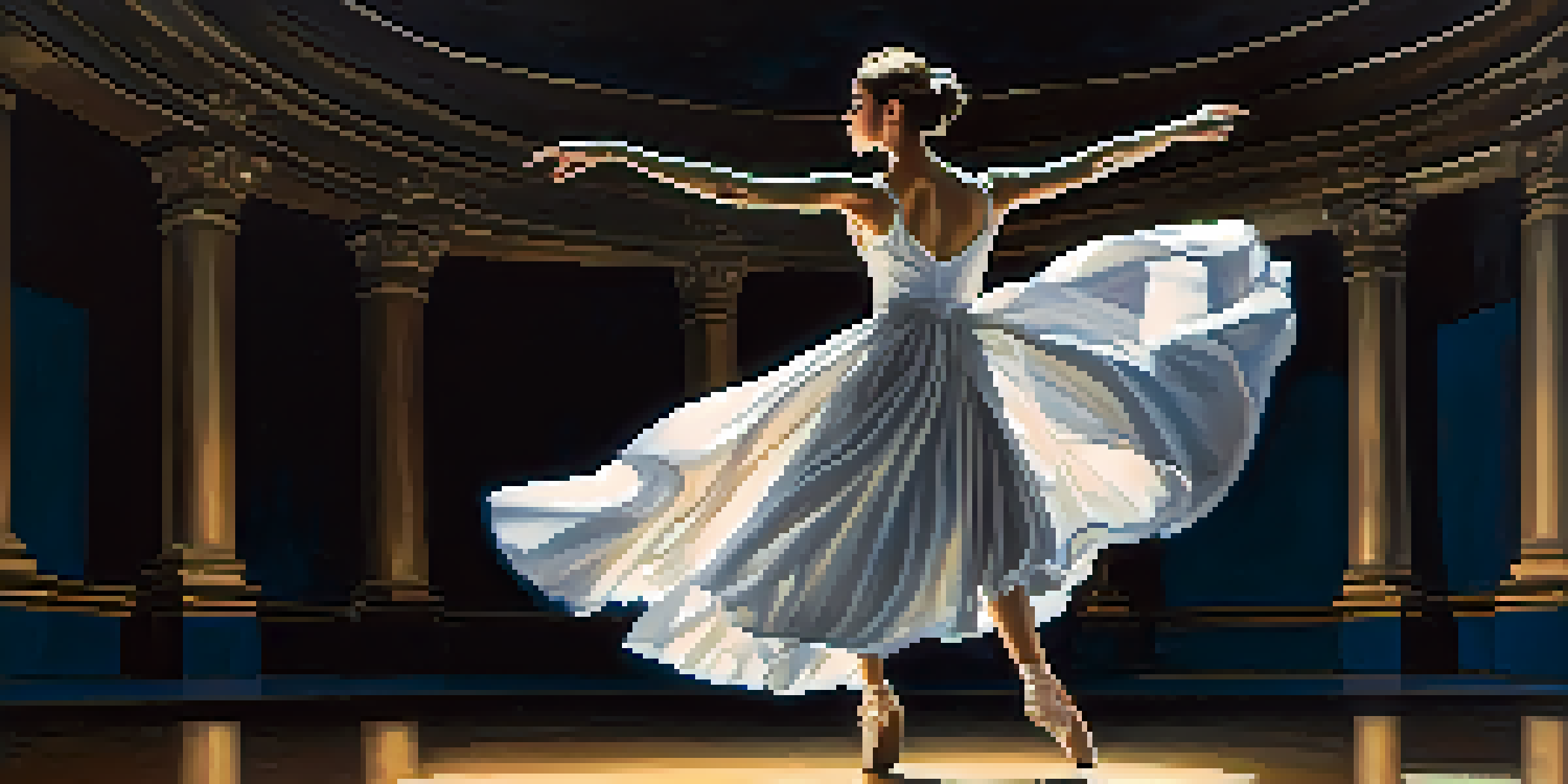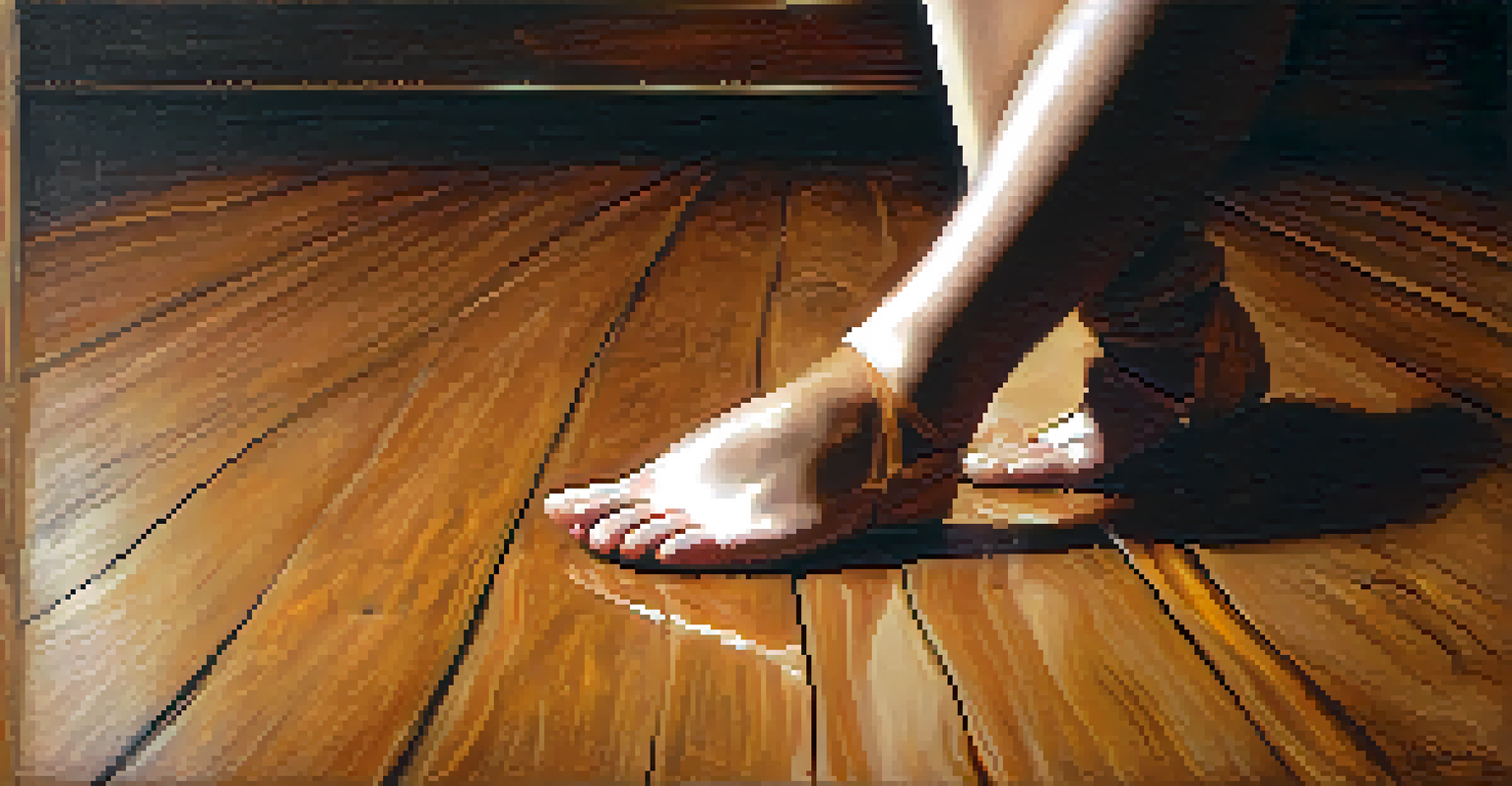Sorrow in Motion: How Dance Can Convey Deep Sadness

The Emotional Power of Dance in Expressing Sadness
Dance has a unique ability to express emotions that words often can't capture. Through movement, dancers can convey feelings of sorrow in a visceral way, allowing audiences to connect deeply with the experience. This emotional resonance is what makes dance a powerful medium for exploring complex themes like sadness.
Dance is the hidden language of the soul.
When a dancer performs a melancholic piece, the subtleties in their movements—like slow turns and drooping postures—speak volumes. These physical expressions can evoke empathy, making viewers feel the weight of the dancer's emotions. It’s through these gestures that sorrow can transform into a shared experience.
Moreover, the combination of music and choreography can amplify these feelings. A haunting melody paired with fluid, yet heavy movements can create an atmosphere where sadness is not just seen, but felt. This synergy makes dance a profound method for exploring and conveying deep emotional states.
Historical Context: Dance as a Reflection of Grief
Throughout history, dance has been intertwined with mourning and grief. For example, traditional funeral dances in various cultures serve to honor the deceased while allowing the community to express their sorrow collectively. These rituals highlight how dance can function as a communal outlet for deep emotional pain.

In the context of ballet, many classical pieces, like 'Swan Lake,' incorporate themes of tragedy and loss. The dancers’ movements encapsulate the essence of sadness, allowing audiences to witness the beauty that can emerge from grief. Such performances remind us that sorrow is a universal experience, transcending time and culture.
Dance Expresses Complex Emotions
Through movement, dance captures and conveys feelings of sadness, allowing performers and audiences to connect deeply with shared emotional experiences.
By looking back at these historical practices, we can appreciate how dance has always been a vessel for expressing complex emotions. It underscores the idea that even in our darkest moments, there is a language in movement that speaks to our shared humanity.
Choreography Techniques to Convey Sadness
Choreographers often use specific techniques to evoke sadness in their work. For instance, the use of heavy, grounded movements can create a sense of weight that mirrors the feeling of sorrow. Such techniques allow dancers to embody the emotional state they are portraying, making their performance more impactful.
Dance is the joy of movement and the heart of life.
Additionally, the choice of space and formation can influence the emotional tone of a dance. Dancers might cluster together to symbolize isolation or spread apart to convey loss. These visual cues enhance the storytelling aspect of the performance and deepen the audience's emotional engagement.
Furthermore, pacing plays a crucial role in the portrayal of sadness. Slow, deliberate movements can draw out the emotional weight, allowing audiences to linger in the moment. This thoughtful pacing can transform a performance into a poignant exploration of grief, resonating long after the final bow.
The Role of Music in Enhancing Dance's Emotional Impact
Music is an integral part of dance, particularly when conveying sadness. The right score can amplify the emotions present in a performance, guiding the dancer's movements and the audience's reactions. For instance, a slow, melancholic piano piece can enhance the feeling of longing and desolation in a dance.
Moreover, the interplay between music and movement can evoke a sense of nostalgia, deepening the emotional experience. When dancers interpret the nuances of a haunting melody through their body, it creates a profound connection that resonates with the audience. This synergy between music and dance is what often makes sorrow feel so palpable.
Historical Roots of Dance and Grief
Dance has historically served as a communal outlet for mourning, reflecting collective sorrow across cultures and time.
In this way, the combination of sound and movement forms a narrative that speaks to the heart. Audiences may find themselves swept away by the emotional tide, feeling the sadness not just through sight, but through sound as well. This intricate relationship emphasizes how dance transcends mere physicality, becoming a conduit for shared human experiences.
Contemporary Dance: Redefining Sadness Through Movement
Contemporary dance offers a fresh lens through which sadness can be explored. Unlike classical forms that often adhere to strict structures, contemporary dance embraces fluidity and innovation. This freedom allows choreographers to experiment with unconventional movements, making the expression of sorrow feel more authentic and immediate.
Dancers in contemporary pieces often delve into personal narratives, sharing their own experiences of loss and grief. This personal touch fosters a deep connection with the audience, as they witness raw emotions being laid bare. The vulnerability displayed in these performances resonates profoundly, inviting viewers to reflect on their own experiences of sadness.
Through this lens, dance becomes a therapeutic outlet, not just for the performer but for the audience as well. As viewers engage with these poignant stories, they may find solace in knowing they are not alone in their feelings. This shared experience can be both healing and transformative, illustrating the power of dance to navigate the depths of human emotion.
The Impact of Dance Therapy on Processing Sadness
Dance therapy has emerged as a valuable tool for processing emotions, particularly sadness. Through movement, individuals can express feelings that may be difficult to articulate. This form of therapy encourages participants to explore their emotions in a safe and supportive environment, allowing them to confront their grief.
In dance therapy, clients often find that movement can provide a release. Engaging in physical expression helps to unlock pent-up emotions, making them easier to acknowledge and process. This therapeutic approach can lead to profound insights and healing as individuals navigate their personal journeys through sadness.
Dance Therapy for Emotional Healing
Dance therapy provides a safe space for individuals to process sadness through movement, fostering community and personal healing.
Additionally, dance therapy fosters a sense of community and connection. Participants often share their experiences and support one another, creating a nurturing space for healing. This collective experience reinforces the idea that sorrow is a shared human condition, emphasizing the importance of connection in overcoming emotional challenges.
Conclusion: Embracing Sadness Through Dance
In conclusion, dance serves as a powerful medium for conveying deep sadness. Through movement, music, and choreography, dancers can express complex emotions that resonate with audiences on a profound level. This unique form of expression allows for a shared exploration of sorrow, fostering connection and empathy.
As we’ve seen, dance has a rich history of embodying grief and loss, reflecting the human experience in all its complexity. Whether through classical ballet or contemporary forms, the act of dancing provides a space for both performers and audiences to confront their emotions and find solace in shared experiences.

Ultimately, embracing sadness through dance can be a transformative journey. It reminds us that even in our darkest moments, there is beauty in vulnerability and strength in expression. By allowing sorrow to be part of our dance, we can create powerful narratives that resonate with the heart and soul.